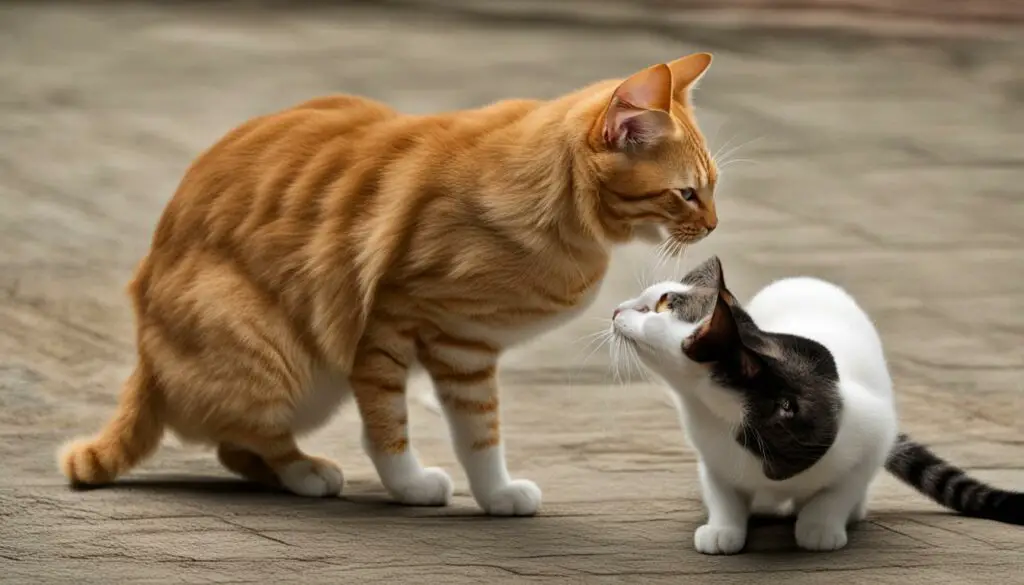Greetings, cat lovers! If you’re facing the challenge of introducing two cats when one is aggressive, you’re in the right place. Aggression can make the process stressful, but fear not! With the right approach and a little patience, you can create a harmonious relationship between your feline friends. Let’s dive in and explore some expert tips and techniques to make this introduction a success!
Introducing cats requires a deep understanding of their behavior and unique personalities. When one cat is aggressive, it becomes even more crucial to navigate the introduction process carefully. By following the right steps and paying attention to the cats‘ body language, you can help them overcome their differences and form a bond. Let’s explore some key strategies to make this happen.
Key Takeaways:
- Understand the behavior and body language of your cats.
- Create separate spaces for each cat to ensure their comfort.
- Avoid reinforcing aggressive behavior and focus on positive reinforcement.
- Introduce the cats gradually and use controlled meetings.
- Use distractions and play to diffuse tension and build positive associations.
Understanding Cat Behavior and Aggression
When introducing two cats, especially when one is aggressive, it is crucial to have a deep understanding of their behavior and aggression triggers. Cats are territorial animals with a complex social hierarchy, and introducing a new cat can disrupt their established order. This can lead to aggression as they try to assert dominance and protect their territory.
Cat aggression can manifest in various ways, from hissing and growling to swatting and biting. It is vital to recognize the body language of cats to understand their intentions and emotions. For example, a cat with an arched back, puffed-up tail, and dilated pupils may be displaying defensive aggression. On the other hand, a cat with flat ears, a tense body posture, and direct eye contact may be exhibiting offensive aggression.
By understanding cat behavior, owners can better manage and prevent aggression during the introduction process. This includes recognizing the importance of cat socialization, allowing cats to establish their hierarchy, and being mindful of their body language cues. With this knowledge, owners can create a safe and comfortable environment and implement strategies to minimize aggression.
Table: Common Cat Aggression Triggers
| Triggers | Description |
|---|---|
| Resource Guarding | Cats may become aggressive when protecting their food, water, toys, or other resources. |
| Territorial Intrusion | Introducing a new cat into an established cat’s territory can cause aggression as they defend their space. |
| Lack of Socialization | Cats that have not been properly socialized may exhibit fear-based aggression towards unfamiliar cats. |
| Stress or Anxiety | Cats may display aggression as a response to stressful situations or changes in their environment. |
| Poorly Managed Introductions | If introductions are rushed or not conducted in a controlled manner, it can lead to increased aggression. |
Understanding cat behavior, including their socialization needs, hierarchy, and body language, is fundamental in successfully introducing two cats and managing aggression. By recognizing common aggression triggers and implementing appropriate strategies, owners can create a harmonious and peaceful relationship between their cats.
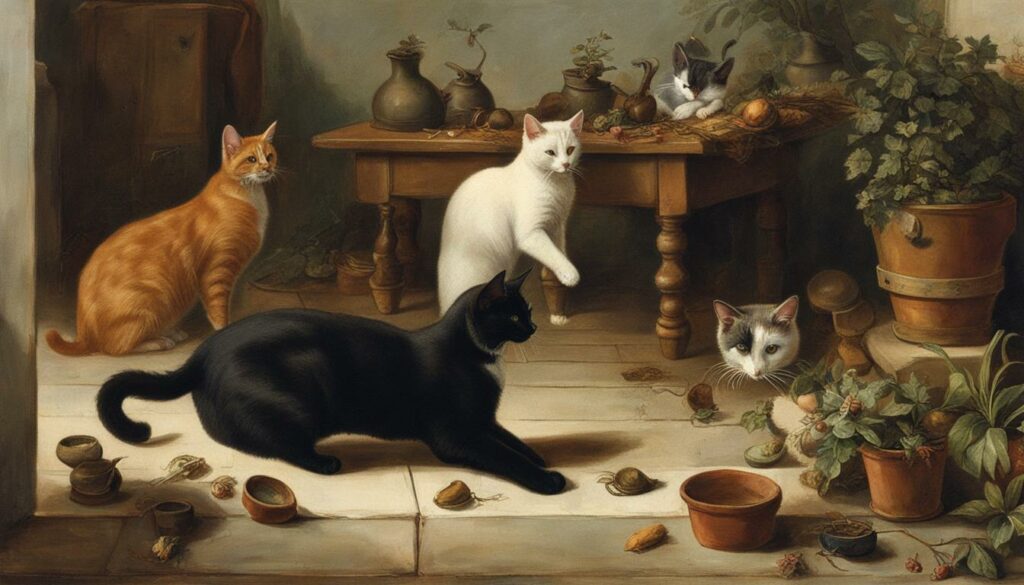
Creating Separate Spaces for Each Cat
When introducing two cats, especially when one has aggressive tendencies, it is crucial to provide each cat with their own space. By creating separate spaces, you can help prevent territorial conflicts and allow the cats to adjust to each other at their own pace.
Start by designating separate rooms for each cat. These rooms should be equipped with all the necessary resources, such as food bowls, water bowls, litter boxes, and comfortable beds. The goal is to ensure that each cat has everything they need without feeling the need to compete or guard their resources.
In addition to having separate rooms, it’s important to gradually introduce the cats to each other’s scents. This can be done by swapping bedding or using scent diffusers. By familiarizing themselves with each other’s smells, the cats can become more comfortable and less defensive when they eventually meet face-to-face.
Table: Cat Separation Techniques
| Separation Technique | Description |
|---|---|
| Separate Rooms | Designate individual rooms for each cat, providing them with their own resources. |
| Scent Introduction | Gradually introduce the cats to each other’s scents through bedding swapping or scent diffusers. |
| Gradual Interaction | Allow the cats to interact through a barrier, such as a baby gate, to gradually get used to each other’s presence. |
Remember, patience is key during this process. Each cat may require different amounts of time to adjust to the new living arrangement. By providing them with their own spaces and allowing them to become familiar with each other gradually, you can help reduce the likelihood of aggression and promote a more peaceful introduction.
Avoid Reinforcing Aggressive Behavior
When dealing with cat aggression, it’s crucial to avoid reinforcing negative behaviors. Rewarding aggressive actions can inadvertently encourage more aggressive behavior in the future. Instead, focus on implementing positive reinforcement techniques to promote calm and sociable behavior in your cats.
One effective way to reinforce positive behavior is through rewards and praise. Whenever your cats display friendly and non-aggressive actions towards each other, provide treats and verbal praise to reinforce that behavior. This positive association will help them understand that peaceful interactions are rewarded and encouraged.
Additionally, incorporating calming techniques can help reduce aggression in cats. Consider using pheromone diffusers or sprays, which release synthetic pheromones that mimic natural calming signals in cats. These pheromones can help create a more relaxed environment and reduce stress-related aggression.
Summary:
- Avoid rewarding aggressive behavior in cats to discourage future acts of aggression.
- Use positive reinforcement techniques, such as treats and praise, to encourage non-aggressive behaviors.
- Implement calming techniques, like pheromone diffusers, to create a more relaxed environment and reduce stress-related aggression.
Table: Cat Calming Techniques
| Technique | Description |
|---|---|
| Pheromone Diffusers | Release synthetic pheromones to create a sense of calm and reduce stress-related aggression. |
| Calming Music or Sounds | Play soothing music or use calming sound machines to promote relaxation in cats. |
| Safe Hiding Places | Provide secure hiding spots, such as covered beds or elevated perches, where cats can retreat to when feeling anxious or threatened. |
| Regular Play and Exercise | Engage in interactive play sessions with your cats to release pent-up energy and reduce stress levels. |
By avoiding reinforcement of aggressive behavior and using positive reinforcement and calming techniques, you can help create a more peaceful and harmonious environment for your cats.
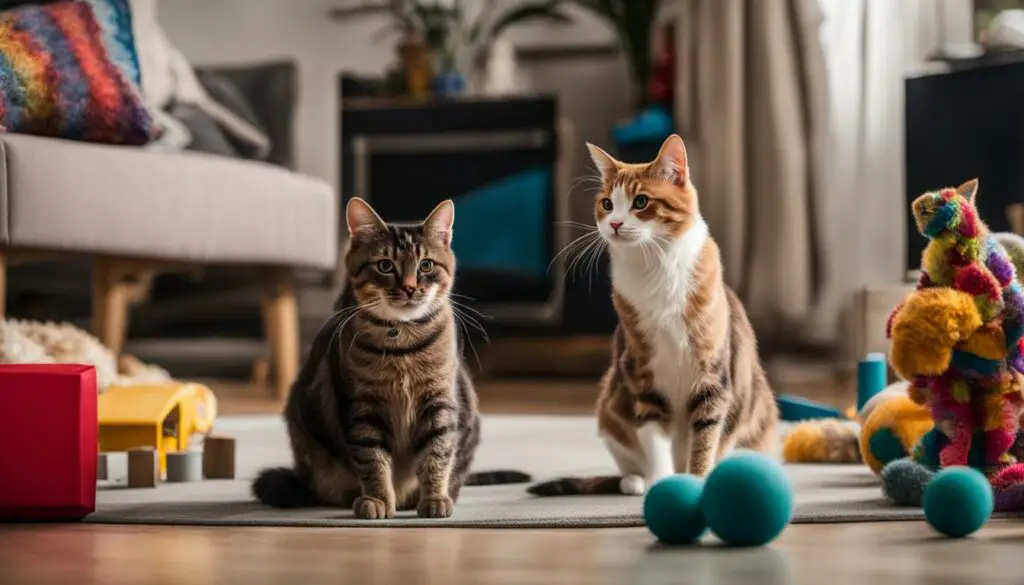
Cat Introduction Techniques: Gradual Introductions and Controlled Meetings
When introducing two cats, especially when one is aggressive, it’s essential to take a gradual approach to ensure a successful integration. One effective technique is to start with scent introductions, allowing the cats to become familiar with each other’s scent before any face-to-face interactions occur. This can help reduce the likelihood of aggressive behavior and create a more comfortable environment for both cats.
To implement scent introductions, you can use a method called scent swapping. This involves rubbing a cloth or towel on one cat’s cheeks and then placing it near the other cat’s feeding area or sleeping spot. By exchanging scents, the cats can gradually recognize each other as a part of their environment, making the introduction process smoother.
“Gradual introductions allow cats to adjust to each other’s presence in a controlled and less threatening manner.”
Once the cats have become familiar with each other’s scent, you can move on to controlled meetings. This involves using a barrier, such as a baby gate or screen, to separate the cats while allowing them to observe and interact with each other. This controlled environment helps the cats adjust to each other’s presence without direct contact, minimizing the risk of aggression.
During controlled meetings, it’s crucial to closely monitor the cats’ behavior and body language. Signs of aggression, such as growling, hissing, or raised fur, should be taken as a cue to separate the cats and allow them to calm down before trying again. Gradually increasing the duration and frequency of these controlled meetings can help the cats build positive associations with each other over time.
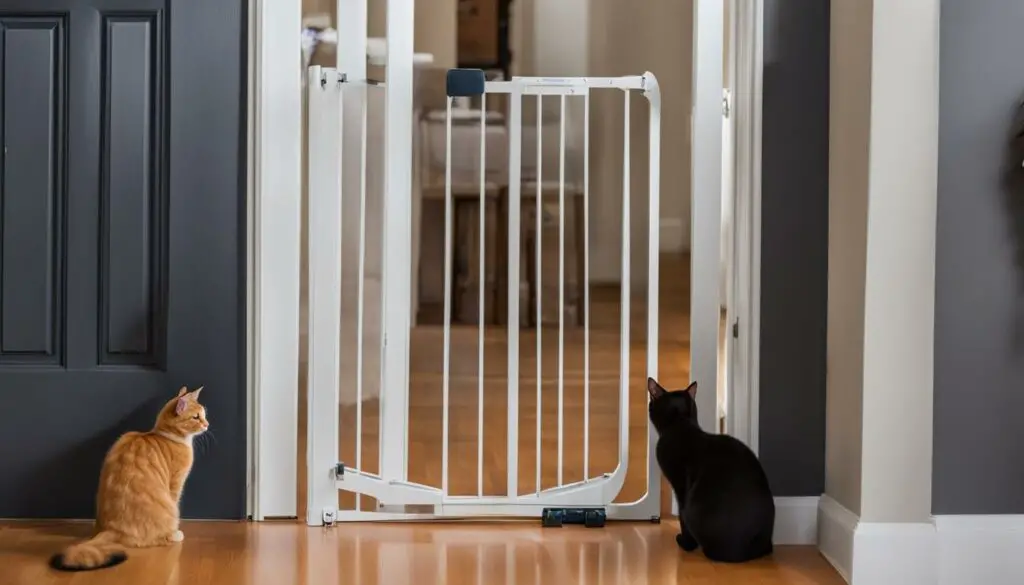
| Benefits of Gradual Introductions and Controlled Meetings | Key Tips for Successful Introductions |
|---|---|
|
|
By implementing gradual introductions and controlled meetings, you can create a safe and comfortable environment for both cats. Remember, every cat is unique, and the introduction process may take time. Patience, observation, and positive reinforcement will help foster a harmonious relationship between your feline companions.
Using Distractions and Play to Diffuse Tension
During the process of introducing two cats, play and distractions can play a significant role in diffusing tension and reducing aggression. Cats are naturally playful creatures, and engaging them in interactive play sessions can help redirect their energy and focus away from aggressive behaviors. By providing appropriate toys and play opportunities, you can promote positive interaction and create a conducive environment for the cats to bond.
One effective way to use play as a distraction is by introducing interactive toys that stimulate the cats’ natural hunting instincts. Toys that mimic prey, such as small mice or feather wands, can help redirect any aggressive tendencies towards a more appropriate target. Encouraging the cats to chase, pounce, and swat at these toys can channel their energy into a fun and engaging activity, reducing the likelihood of aggressive behavior.
It is important to closely monitor the play interactions between the cats and intervene if play aggression escalates. Signs of play aggression can include biting, scratching, or excessive roughness. If this occurs, immediately redirect their attention to a suitable toy or engage them in a different interactive activity. Taking breaks between play sessions can also help prevent overstimulation and potential aggression.
Recognizing Cat Play Signals
Understanding cat play signals is vital to ensure safe and positive interactions. Cats communicate through body language and behavior, and being able to recognize these signals can help prevent misunderstandings and potential conflicts. Some common play signals include:
- Ears slightly flattened with pupils dilated
- Tail twitching or wagging
- Low, crouched body posture
When observing these signals during play, it is important to note that they are often accompanied by relaxed facial expressions and loose body movements. If you notice any signs of aggression or tension, such as ears flattened close to the head, raised fur, or hissing, it is important to intervene and redirect the cats’ behavior to prevent escalation.
| Cat Play Behavior | Description |
|---|---|
| Chasing | One cat chases another in a playful manner, taking turns being the “chaser” and the “chased”. |
| Pouncing | Cats take turns pouncing on each other, playfully tackling and wrestling without causing harm. |
| Batting and Swatting | Cats engage in gentle paw swipes and batting, mimicking hunting behaviors without causing harm. |
| Rolling and Wrestling | Cats roll around and wrestle with each other, often playfully biting and kicking. |
By incorporating play and using distractions effectively, you can promote positive interactions between the cats and reduce stress and aggression. Remember to closely supervise play sessions, recognize and respond to cat play signals, and intervene if any signs of aggression arise. With patience and consistency, play can be a valuable tool in fostering a harmonious relationship between two cats.
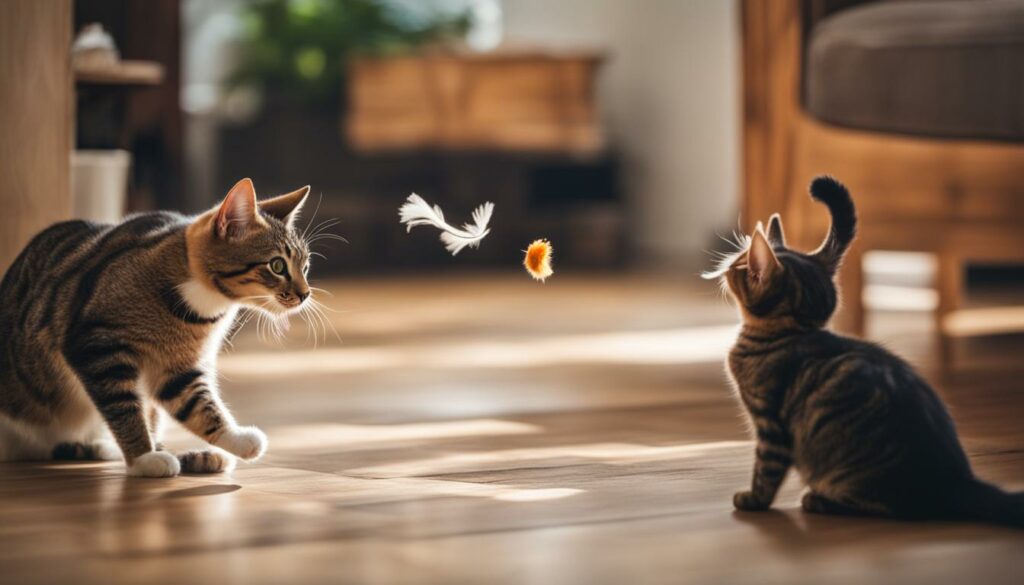
Managing Feeding Time and Resources
When introducing two cats, managing feeding time and resources is crucial to prevent aggression and ensure a peaceful coexistence. Cats can display territorial behavior and resource guarding, which can escalate into redirected aggression if not addressed. By following some key strategies, you can create a harmonious feeding environment for your cats.
Separate Feeding Areas
Providing each cat with their own designated feeding area is essential. This ensures that they have access to food without feeling threatened by the presence of the other cat. Separate feeding areas can be as simple as placing the food bowls in different rooms or in opposite corners of the same room. This physical distance helps minimize the potential for competition and aggression during mealtime.
Monitor Resource Guarding
Some cats may exhibit resource guarding behavior, where they become possessive over their food or other resources. This can lead to aggression towards the other cat if they perceive a threat to their possessions. It’s important to closely monitor their behavior during feeding time and intervene if necessary.
Quote: “By closely observing their body language and behavior, you can identify signs of resource guarding, such as growling, hissing, or stiff postures. If you notice any signs of aggression, try to distract them by making a noise or tossing a toy away from the food area.”
By redirecting their attention away from the food and providing positive distractions, you can help defuse any potential conflicts. It’s also important to ensure that each cat has access to their own food bowl, water source, and litter box to prevent competition over resources.
| Common Signs of Resource Guarding | Intervention Strategies |
|---|---|
| Growling or hissing during feeding | – Make a noise to distract them – Toss a toy away from the food area |
| Blocking access to food or litter boxes | – Provide multiple feeding and litter box options – Space them out in different areas |
| Guarding behavior (e.g., standing over the food) | – Use a treat to lure them away from the food – Gradually decrease the distance between the cats’ feeding areas over time |
By implementing these strategies and closely monitoring your cats during feeding time, you can help minimize aggression and foster a positive feeding experience for both cats.

Addressing Fear and Anxiety in Cats
Fear and anxiety can contribute to aggressive behavior in cats. It’s important to recognize and address the stress signals they exhibit during the introduction process. By understanding and responding to their needs, we can create a calm and supportive environment for the cats to feel safe and comfortable. Here are some key strategies:
- Provide hiding places: Cats often seek refuge in hiding spots when they feel stressed. Create cozy hideaways using cat beds, boxes, or dedicated hiding furniture. These safe spaces give cats a sense of security and help alleviate their anxiety.
- Use pheromone diffusers: Feliway is a synthetic pheromone that mimics a cat’s facial pheromone, creating a calming effect. Plugging in diffusers around the house can help to reduce fear aggression and create a more relaxed atmosphere.
- Practice positive reinforcement: Rewarding desired behaviors with treats or praise can help build trust and confidence in fearful cats. Focus on reinforcing calm and relaxed behaviors, gradually helping them associate positive experiences with the presence of the other cat.
Additionally, it’s important to monitor the cats closely for signs of stress, such as excessive grooming, dilated pupils, or withdrawal. If the stress signals persist or worsen, it may be necessary to consult a veterinarian or a cat behavior specialist for further guidance.
Creating a calm and supportive environment is key to helping cats overcome fear and anxiety during introductions.
| Stress Signal | Signs |
|---|---|
| Tail flicking | Quick and forceful movements of the tail from side to side. |
| Ear flattening | Ears pulled tightly back against the head. |
| Hissing or growling | Warning vocalizations indicating fear or agitation. |
| Pacing | Repetitive, restless movement back and forth. |
| Wide-eyed stare | Dilated pupils and an intense gaze. |
By incorporating these strategies and being attentive to their needs, we can help cats overcome fear and anxiety, reducing the likelihood of aggression and creating a more harmonious environment during their introduction.
Cat Aggression Management and Rehabilitation
When it comes to dealing with aggressive behavior in cats, seeking professional help can be a valuable resource. A cat behavior consultation with a knowledgeable specialist can provide tailored guidance and strategies to manage and rehabilitate cat aggression. These experts have the expertise to understand the root causes of aggression and develop effective solutions for long-term behavioral change.
During a cat behavior consultation, the specialist will assess the aggressive behaviors, identify triggers and underlying issues, and create a customized behavior modification plan. This may include techniques such as desensitization and counterconditioning, which help cats associate positive experiences with previously threatening situations.
The Benefits of Professional Help
There are several benefits to seeking professional help for cat aggression management and rehabilitation. Firstly, a behavior specialist can provide an objective perspective and unbiased advice. They have experience working with various cat breeds and temperaments and can offer insights that may not be apparent to the cat owner. Additionally, these specialists have access to a wide range of resources and tools, including calming pheromone products and interactive toys.
Furthermore, a cat behavior consultation can save time and reduce stress for both the cat owner and the cat. The specialist will provide step-by-step guidance on how to implement behavior modification techniques effectively. They can also educate the owner on understanding cat body language and communication, enabling them to better interpret and respond to their cat’s needs.
| Benefits of Professional Help for Cat Aggression |
|---|
| Objective perspective and unbiased advice |
| Access to a wide range of resources and tools |
| Saving time and reducing stress for both owners and cats |
| Step-by-step guidance on behavior modification techniques |
| Educating owners on cat body language and communication |
Remember, every cat is unique, and what works for one cat may not work for another. Seeking professional help ensures that the approach is tailored to the individual cat’s needs. With the right guidance and persistence, it is possible to manage and rehabilitate cat aggression, leading to a happier and more harmonious relationship with your feline companion.
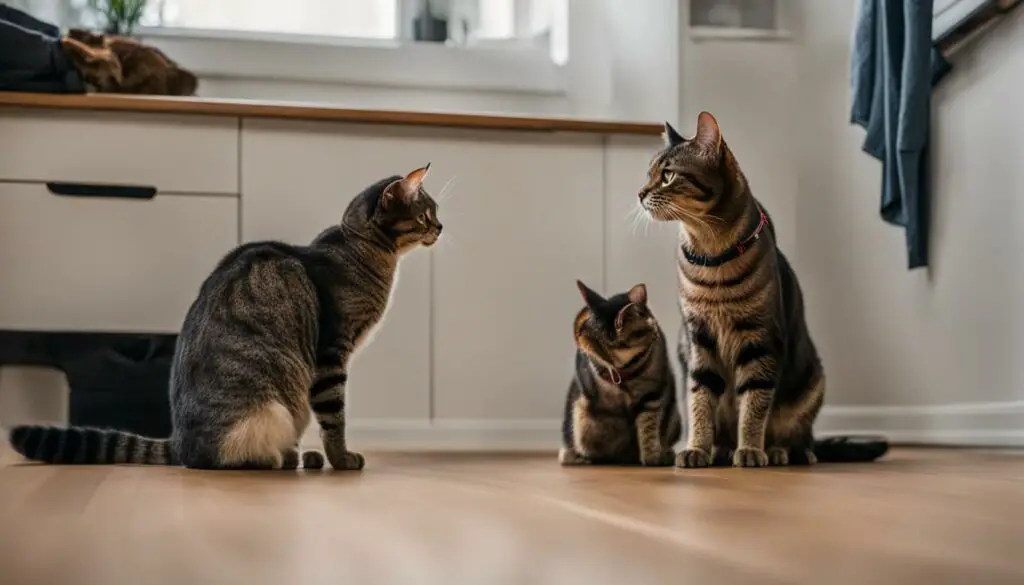
Understanding Cats’ Natural Behavior
When introducing two cats, it’s crucial to understand their natural behavior, which includes territory marking, scent marking, social bonding, and social hierarchy. Cats are inherently territorial animals, and they use territory marking as a way to establish boundaries and communicate with other cats. This behavior can be particularly important to consider when introducing a new cat to a resident cat.
Scent marking is another natural behavior that cats engage in to communicate with each other. By marking their territory with their scent, cats are able to establish a sense of ownership and familiarity. Understanding scent marking can help you navigate the introduction process and create a more comfortable environment for both cats.
In addition to territory and scent marking, cats also engage in social bonding. They form relationships with other cats, both within their social group and outside of it. By understanding the importance of social bonding, you can facilitate a smoother introduction between two cats and promote positive interactions.
Finally, it’s essential to be aware of the social hierarchy that exists among cats. Each cat has its own position within the hierarchy, which can influence their behavior and interactions with other cats. Knowing where each cat falls within the social hierarchy can help you manage any potential conflicts and ensure a more harmonious introduction process.
| Behavior | Description |
|---|---|
| Territory Marking | Cats mark their territory with scent to establish boundaries and communicate with other cats. |
| Scent Marking | Cats use scent marking to establish a sense of ownership and familiarity in their environment. |
| Social Bonding | Cats form relationships with other cats and engage in social interactions. |
| Social Hierarchy | Cats have a social hierarchy that influences their behavior and interactions with other cats. |
Understanding these natural behaviors is key to successfully introducing two cats when one is aggressive. By creating a safe and comfortable environment that takes their behaviors and needs into account, you can help foster a positive relationship between the cats and ultimately create a harmonious household.
Taking Time and Patience
Introducing two cats when one is aggressive requires patience and a gradual approach. It’s important to understand that every cat is unique, and the process of socialization and integration takes time. By following a few key strategies, you can help both cats feel more comfortable and build a positive relationship.
Gradual Socialization Exercises
One effective way to introduce two cats is through gradual socialization exercises. This involves keeping the cats in separate rooms initially and gradually allowing them to interact in controlled situations. Start by swapping scents between the cats, such as using a towel to rub each cat and then placing it in the other cat’s space. This helps the cats become familiar with each other’s scent and reduces the stress of a direct introduction.
Once the cats show signs of curiosity and relaxation, you can start allowing them to see each other through a barrier, such as a baby gate or a cracked door. This allows them to begin understanding each other’s presence without the risk of direct conflict. Gradually increase the duration of these controlled meetings until both cats become comfortable enough to interact without the barrier.
Stress Reduction Techniques
Cats can easily become stressed or anxious during the introduction process. To help reduce their stress levels, create a calm environment by providing hiding places, cozy beds, and vertical spaces like shelves or cat trees. These safe zones give the cats a sense of security and a place to retreat if they feel overwhelmed.
In addition, consider using pheromone diffusers or sprays, which release calming scents that mimic a cat’s natural facial pheromones. These pheromones can help create a more relaxed atmosphere and ease any tension between the cats. Regular play sessions with interactive toys can also help release pent-up energy and redirect any aggressive behavior into positive play.
Remember, taking your time and being patient throughout the introduction process is key. Rushing the cats’ interactions or forcing them together too quickly can lead to increased aggression and stress. By gradually introducing the cats and providing a stress-free environment, you give them the best chance to form a bond and enjoy a harmonious relationship.
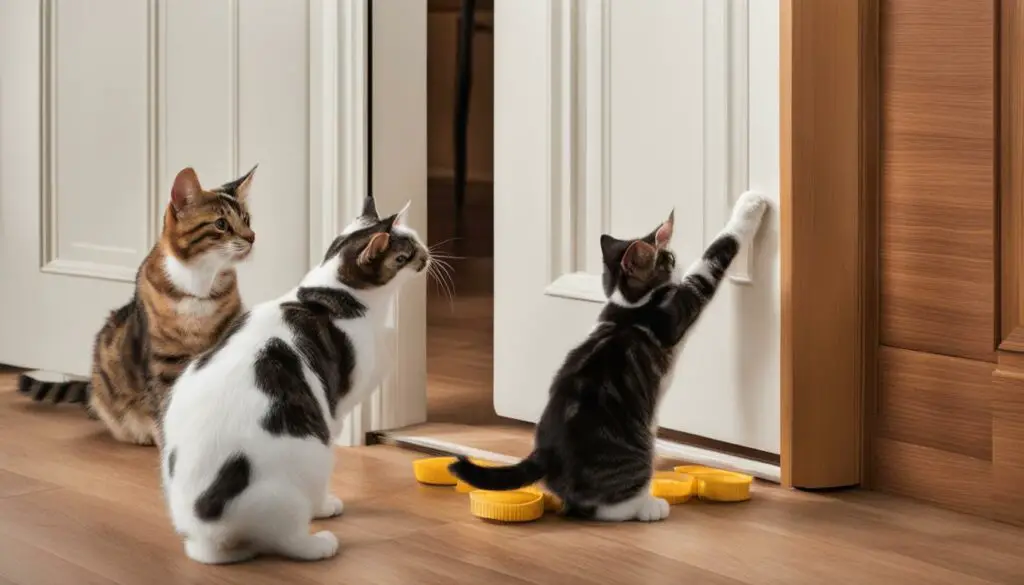
Providing Enrichment and Resources
When introducing two cats, especially when one is aggressive, it’s important to provide them with a stimulating environment that caters to their natural instincts. Enrichment and resources play a crucial role in reducing tension and promoting positive interactions.
Creating a Playful Environment
Cat play behavior is a vital aspect of their socialization process and can help in reducing aggression. By offering a variety of interactive toys, scratching posts, and climbing structures, you can encourage play and provide cats with an outlet for their energy. Engaging in daily play sessions with each cat individually can help establish a positive association and strengthen the bond between them.
Designating Territory Marking Areas
Cats have a natural instinct to mark their territory through scent marking. By providing designated areas for territory marking, such as scratching posts and vertical surfaces, you can reduce the likelihood of aggressive behavior related to territory disputes. Additionally, using pheromone spray or diffusers can help create a calming environment and promote a sense of security for both cats.
Recognizing Cat Scent and Establishing Scent Recognition
Cat scent recognition is an essential part of their social bonding process. Encourage scent recognition by exchanging bedding or using a soft cloth to rub each cat’s scent and then transferring it to the other cat. This will allow them to become familiar with each other’s scent and can help in easing the introduction process.
| Enrichment and Resources | Benefits |
|---|---|
| Interactive Toys | Engages cats in play, reduces aggression, and strengthens the bond between them. |
| Scratching Posts and Climbing Structures | Provides cats with an outlet for natural behaviors and helps reduce territorial disputes. |
| Territory Marking Areas | Allows cats to mark their territory, reducing the likelihood of aggression related to territorial disputes. |
| Pheromone Spray or Diffusers | Creates a calming environment and promotes a sense of security for both cats. |
| Scent Recognition | Facilitates the bonding process by familiarizing cats with each other’s scent. |
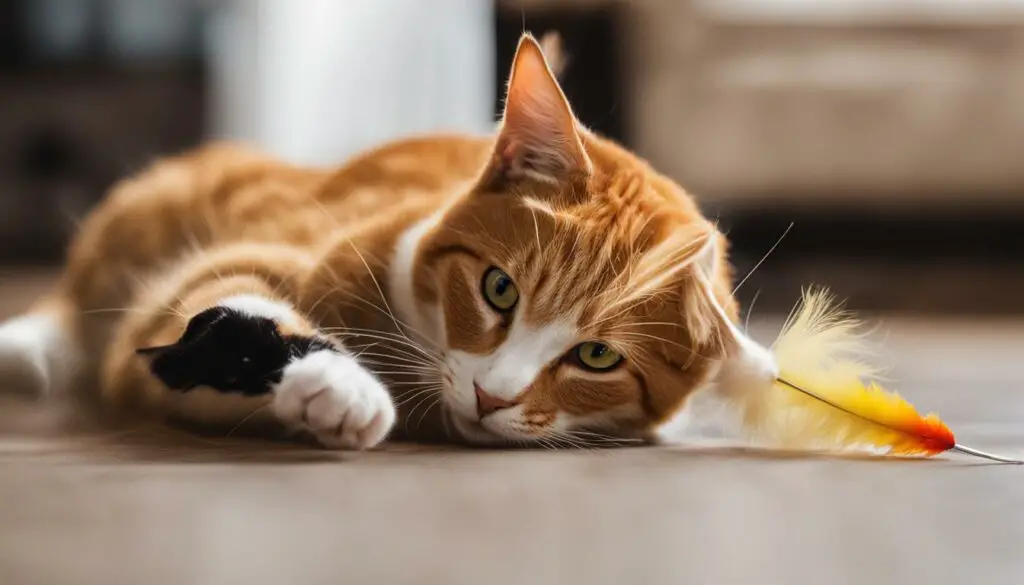
Providing enrichment and resources not only helps alleviate aggression but also enhances the overall well-being of your cats. Remember, every cat is unique, so it’s vital to tailor the enrichment activities based on their individual preferences and personalities. By creating a stimulating environment, you can pave the way for a successful and harmonious introduction between your feline companions.
Avoiding Physical Interventions
When it comes to dealing with cat aggression, it’s important to prioritize safety and avoid physical interventions that could potentially lead to injuries. Instead, there are several alternative strategies that can be employed to separate fighting cats and diffuse tense situations.
Distractions: Using distractions can help redirect the cats’ attention away from their aggressive behavior. Loud noises, like clapping or using a whistle, can startle them and create a momentary break in the conflict. Additionally, throwing a blanket over the fighting cats can temporarily disorient them and provide an opportunity for separation.
Separation: When physical intervention is necessary, it’s essential to do so in a way that minimizes the risk of harm. One effective method is to use a board or a piece of cardboard to gently nudge the agitated cat away from the other cat. This can create enough space for them to calm down and establish a safe distance.
Cat fights can be intense, and it’s crucial to remember that intervening physically can escalate the situation further. Always prioritize the safety of both cats and yourself.
Seeking professional help: If the aggression persists or escalates to the point where it poses a serious threat, it’s important to seek assistance from a professional cat behavior specialist. They can provide expert guidance and advice on managing the aggression and creating a safe environment for your cats.
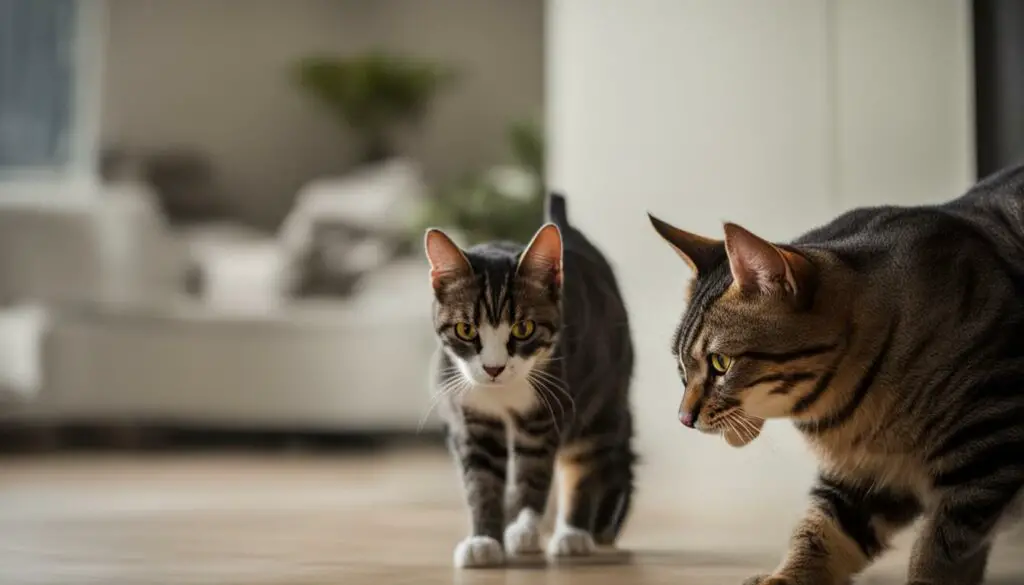
| Aggression Type | Response |
|---|---|
| Aggression towards humans | Seek professional help immediately and keep yourself and others safe by avoiding direct physical confrontation |
| Aggression towards other animals | Implement distraction techniques and consider separating the animals to prevent further conflicts. Seek professional guidance if the aggression continues. |
Considering Individual Cat Personalities
When introducing two cats, it’s crucial to take into account their individual personalities. Just like humans, cats have unique characteristics and behaviors that can influence their interactions. Understanding the dominant and submissive behaviors, as well as their social bonding tendencies, can help pave the way for a successful introduction.
Cat dominance behavior refers to the display of assertiveness and control over resources, territory, and other cats. Dominant cats may exhibit behaviors such as marking their territory, being vocal, and displaying confident body language. On the other hand, submissive cats tend to be more passive, avoiding conflict, and showing deference to dominant cats.
Building a positive social bond between two cats involves creating an environment that allows them to explore and interact at their own pace. By observing their behaviors and body language, you can gauge their compatibility and make adjustments accordingly. Encouraging play sessions and providing shared experiences, such as mealtime or playtime together, can help foster a sense of camaraderie.
| Cat Dominance Behavior | Cat Submissive Behavior | Cat Social Bonding |
|---|---|---|
| Marking territory | Avoiding conflict | Shared experiences |
| Vocalization | Showing deference | Observing body language |
| Confident body language | Passive behavior | Encouraging play sessions |
Remember, each cat is unique, and their personalities will play a significant role in their interactions. By considering their dominant or submissive tendencies, as well as their social bonding potential, you can create a more harmonious environment for the cats to thrive and form a lasting bond.
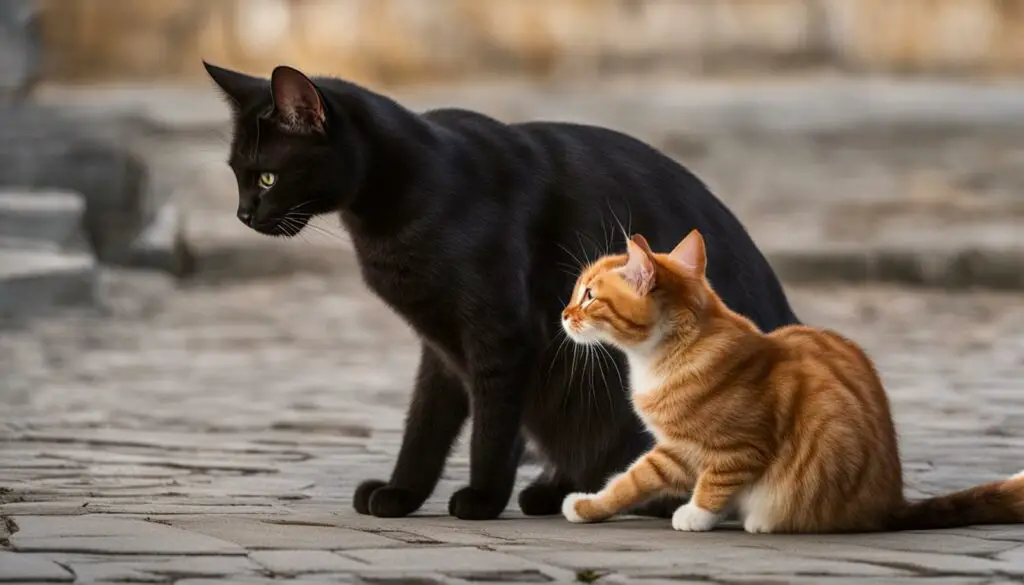
Creating a Safe and Comfortable Environment
When introducing two cats, especially when one is aggressive, it is crucial to create a safe and comfortable environment for both felines. This will help alleviate stress, reduce the chances of aggressive behavior, and promote a harmonious relationship between the cats.
One important aspect to consider is the cat social hierarchy. Cats have a natural instinct for establishing a hierarchy within their social group. By providing hiding places, perches, and vertical spaces, you can allow each cat to have their own territory and feel secure. This will help prevent conflicts and reduce the likelihood of aggression.
In addition to providing hiding places and vertical spaces, it is essential to minimize stressors in the environment. Cats are sensitive creatures, and various factors like loud noises, crowded areas, or sudden changes can increase their stress levels. By creating a calm and predictable environment, you can help reduce stress and promote a peaceful coexistence between the cats.
Benefits of creating a safe and comfortable environment:
- Reduces stress and anxiety in both cats
- Allows each cat to establish their territory and feel secure
- Minimizes the likelihood of aggressive behavior
- Promotes a harmonious relationship and positive interactions between the cats
To summarize, creating a safe and comfortable environment is essential when introducing two cats, especially when one exhibits aggression. By understanding the cat social hierarchy, providing hiding places and perches, and minimizing stressors, you can help create a peaceful environment where the cats can coexist and build a bond over time.
| Benefits of Creating a Safe and Comfortable Environment |
|---|
| Reduces stress and anxiety in both cats |
| Allows each cat to establish their territory and feel secure |
| Minimizes the likelihood of aggressive behavior |
| Promotes a harmonious relationship and positive interactions between the cats |
Conclusion
In conclusion, introducing two cats when one is aggressive can be a challenging process. However, by following the right techniques and having patience, it is possible to create a harmonious relationship between the cats. The key to a successful introduction is understanding cat behavior, providing separate spaces for each cat, and avoiding reinforcing aggressive behavior.
Gradual introductions and controlled meetings, along with using distractions and play to diffuse tension, can also help the cats adjust and form a bond over time. It’s important to address fear and anxiety in cats and to manage feeding time and resources to prevent aggression. Seeking professional help should be considered if the aggression persists.
When introducing two cats, it’s crucial to take into account their individual personalities and create a safe and comfortable environment. By considering their natural behavior and providing enrichment and resources, the cats will feel more secure and less likely to exhibit aggression. Remember, patience and understanding are key to a successful introduction and a peaceful coexistence between the cats.
FAQ
How can I introduce two cats when one is aggressive?
Introducing two cats when one is aggressive requires time and patience. Gradual socialization exercises and stress reduction techniques can help the cats integrate and form a bond over time.
How do I understand cat behavior and aggression?
Understanding cat behavior, socialization, and body language is crucial in managing their aggression and creating a peaceful environment.
What can I do to create separate spaces for each cat?
Providing each cat with their own space is important during the introduction process. Separate rooms with their own resources give the cats time to adjust and feel secure.
How can I avoid reinforcing aggressive behavior in cats?
Instead of rewarding aggressive actions, focus on praising and rewarding positive behaviors. Calming techniques, such as using pheromone diffusers, can also help reduce aggression.
What is the key to preventing aggression during introductions?
Introducing cats gradually is key to preventing aggression. Start by allowing the cats to become familiar with each other’s scent and gradually progress to controlled meetings.
How can I diffuse tension between the cats during interactions?
Distractions, such as toys and treats, can redirect aggressive behavior during interactions. Play sessions can help the cats bond and release stress. Understanding cat play signals is important to ensure safe and positive interactions.
How do I manage feeding time to prevent aggression?
Providing separate feeding areas and monitoring resource guarding can help prevent aggressive behaviors. It’s important to ensure each cat has access to food, water, and other resources without feeling threatened.
How do I address fear and anxiety in cats during introductions?
Recognizing and addressing stress signals and providing a calm environment can help reduce fear aggression during the introduction process.
When should I seek professional help for cat aggression?
If the introductions and aggression persist, seeking professional help from a cat behavior specialist or consultant is recommended. They can provide tailored guidance and strategies to manage and rehabilitate cat aggression.
How can I understand cats’ natural behavior during introductions?
Cats are territorial animals and rely on scent marking to establish their boundaries. Understanding their natural behavior, such as social bonding and hierarchy, can aid in creating a more harmonious environment during introductions.
How important is taking time and patience during the introduction process?
Introducing two cats when one is aggressive requires time and patience. Gradual socialization exercises and stress reduction techniques can help the cats integrate and form a bond over time.
What should I consider when providing enrichment and resources?
Enriching the cats’ environment with scratching posts, beds, perches, and other resources can reduce tensions and provide outlets for play and marking. Ensuring each cat has their own designated resources is essential.
How do I avoid physically intervening during cat aggression?
When cats exhibit aggression, it’s important to avoid physically intervening, as it can lead to injuries. Instead, use distractions, noises, or blankets to separate fighting cats. Safety should always be the top priority.
Why is considering individual cat personalities important during introductions?
Each cat has its own personality and preferences. Some cats may be more dominant, while others are more submissive. Considering individual cat personalities is crucial when introducing two cats and managing aggression.
How can I create a safe and comfortable environment during introductions?
Providing hiding places, perches, and a safe environment is essential for cats to feel comfortable and secure during the introduction process. Understanding their social hierarchy and minimizing stressors can help create a positive environment.
Source Links
- https://www.ddfl.org/resources/introducing-your-new-cat-to-your-resident-cat/
- https://www.paws.org/resources/introducing-cat-to-cat/
- https://www.hepper.com/how-to-introduce-two-cats-when-one-is-aggressive/

